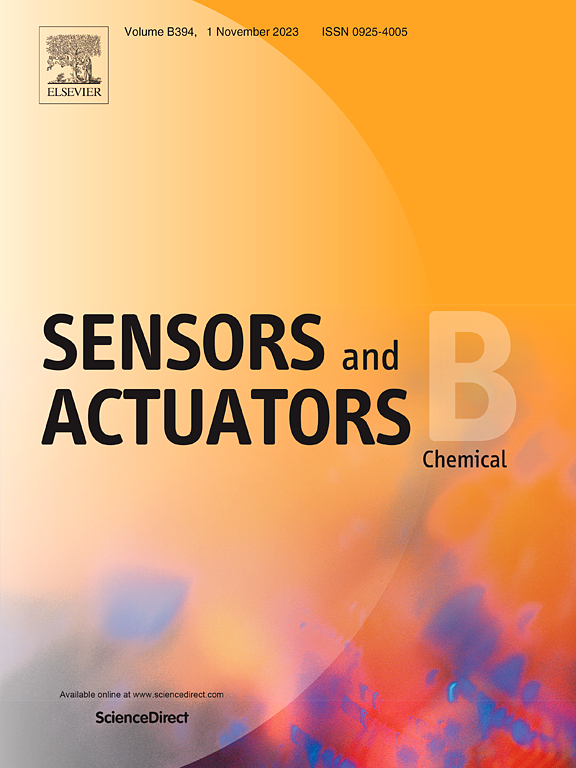利用多重CRISPR Cas12a/Cas13a系统同时检测乳腺癌相关的无细胞DNA和MicroRNA
IF 8
1区 化学
Q1 CHEMISTRY, ANALYTICAL
引用次数: 0
摘要
无细胞dna (cfdna)和microRNAs (miRNAs)在生物医学领域引起了极大的关注,因为它们的异常表达水平与包括癌症在内的多种疾病有关。然而,它们在体液中的浓度通常很低,仅通过测量单个核酸生物标志物来诊断特定疾病存在相当大的挑战。在本研究中,我们利用CRISPR-Cas12a和CRISPR-Cas13a传感策略,提出了乳腺癌源性cfDNA和miRNA的多重传感系统,实现了更准确的乳腺癌诊断。在该系统中,CRISPR-Cas12a和CRISPR-Cas13a分别被靶乳腺癌基因1 (BRCA1)和miRNA-10b选择性激活,导致固定在金纳米棒(aunr)表面的fam标记的ssDNA和rox标记的ssRNA发生反式切割反应。随后,被猝灭的荧光探针转变为脱猝状态,可以根据FAM和ROX测量荧光信号,分别表示BRCA1和miRNA-10b的存在。所提出的同时多重检测系统具有高灵敏度和快速检测(<;cfDNA和miRNA通过直接的酶切反应获得。我们希望提出的这两种核酸的概念验证多重检测系统将为许多疾病的早期准确诊断铺平道路。本文章由计算机程序翻译,如有差异,请以英文原文为准。
Simultaneous detection for breast cancer-associated cell-free DNA and microRNA using multiplex CRISPR Cas12a/Cas13a system
Cell-free DNAs (cfDNAs) and microRNAs (miRNAs) have garnered significant attention in the biomedical field due to their abnormal expression levels associated with a wide range of diseases, including cancers. However, their concentration in bodily fluids is typically low and diagnosing a specific disease solely by measuring a single nucleic acid biomarker presents considerable challenges. In this study, we have achieved more accurate diagnosis of breast cancer by presenting a multiplex sensing system for breast cancer-derived cfDNA and miRNA, leveraging CRISPR-Cas12a and CRISPR-Cas13a sensing strategies. In this system, CRISPR-Cas12a and CRISPR-Cas13a are selectively activated by the target breast cancer gene 1 (BRCA1) and miRNA-10b, respectively, resulting in trans-cleavage reactions on FAM-tagged ssDNA and ROX-tagged ssRNA immobilized on the surface of gold nanorods (AuNRs). Subsequently, the quenched fluorescent probes transition to dequenching states, enabling the measurement of fluorescent signals according to FAM and ROX signifies the presence of BRCA1 and miRNA-10b, respectively. The proposed simultaneous multiple detection system demonstrates high sensitivity and rapid detection (< 1 h) for both cfDNA and miRNA, achieved through straightforward enzymatic cleavage reactions. We hope that the proposed proof-of-concept multiplex detection system for both nucleic acids will pave the way for an early and accurate diagnosis of numerous diseases.
求助全文
通过发布文献求助,成功后即可免费获取论文全文。
去求助
来源期刊

Sensors and Actuators B: Chemical
工程技术-电化学
CiteScore
14.60
自引率
11.90%
发文量
1776
审稿时长
3.2 months
期刊介绍:
Sensors & Actuators, B: Chemical is an international journal focused on the research and development of chemical transducers. It covers chemical sensors and biosensors, chemical actuators, and analytical microsystems. The journal is interdisciplinary, aiming to publish original works showcasing substantial advancements beyond the current state of the art in these fields, with practical applicability to solving meaningful analytical problems. Review articles are accepted by invitation from an Editor of the journal.
 求助内容:
求助内容: 应助结果提醒方式:
应助结果提醒方式:


